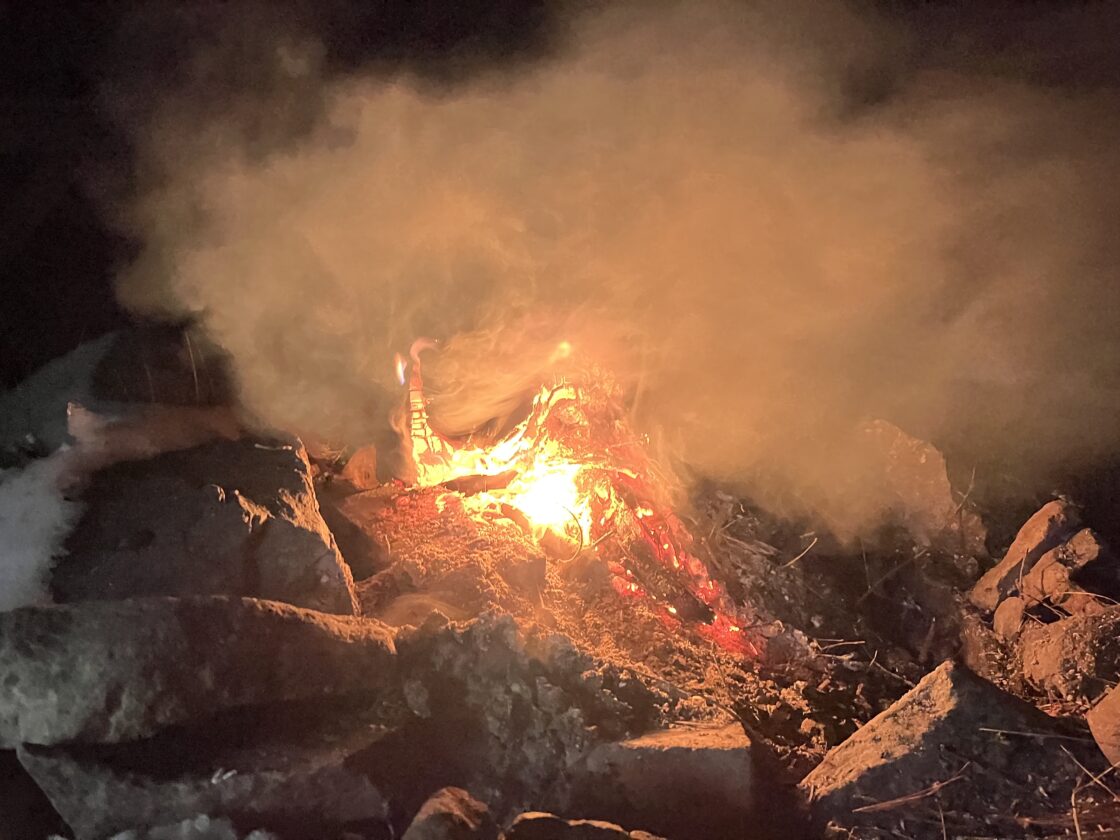I enjoy writing, but I would much rather speak than write. When I saw that this post required we use a digital storytelling medium other than writing to answer the question, I knew that audio recording would be my go-to. It seemed like a shortcut to me. I felt like I was cheating, right up until I was almost finished editing the sound file.
That’s when I realized that audio recording isn’t cheating. Some of my favorite storytellers use audio only. I grew up listening to A Prairie Home Companion every weekend. Garrison Keillor’s monologues and radio dramas with sound effects are a now-digital form of storytelling. I am a fan of a musician who goes by the name Chadwick Stokes whose songs are often stories—stories with deep meanings. I am at home with audio stories.
I planned to record this monologue next to a crackling woodstove, but on the day I recorded it, I decided to work beside a campfire outside. The campfire was just a little too close to a rushing river, so I had to put the microphone (my iPhone) in the fire and sit very close to get the crackling fire and my voice without being drowned out in the rapids. The crackling is a little more intense than I intended, and my voice is a little quieter at the beginning. It’s a little rough, so I’ll include the transcript below.
How does being digital enable new aspects of storytelling?
I struggled for a while with this question.
At first, I didn’t believe that being digital
did add anything that being electronic hadn’t already added.
Analog recording technology—
painting, writing, paper, the printing press,
the camera, the audio recorder, the video camera,
books and pictures and wax cylinders and tapes—
had already made recording, copying, distributing, and broadcasting possible.
I sit here next to the fire talking to you,
just like our ancestors have for generations and millennia,
just like FDR did on the radio.
How is this different, just because it is recorded digitally on my computer?
It is different because it does not exist,
and yet it is almost universally available.
There is no physical, tangible recording of what I am saying,
and you are not listening to me as I am saying it.
You are not next to the fire with me or listening to a live broadcast.
You are listening to a recording that exists only as a code.
There is no physical copy to share,
but it can be shared infinitely.
There is no physical copy to, well, copy,
but it can be copied infinitely.
And with that, it can be changed, edited,
adapted, mixed, and remixed—
at next to no cost and with no risk.
The digital medium is cheap.
The tools are often expensive, but somehow readily available.
My wife is an amateur photographer.
She likes to shoot film.
She says that shooting film is real art.
It takes skill and talent.
She shoots digital, too.
And while she does put significant effort into capturing a shot,
she can take a few and choose the one she likes best.
She isn’t limited by the roll of film.
And when she gets all of the photos on the computer—or her phone,
she can edit them quickly and easily.
She can crop, change light and color, change focus
—and she can undo changes that she doesn’t like.
There is no material cost, no cost for experimentation.
And that is how being digital enables new aspects of storytelling.
There is little or no material cost for experimentation.
And even better: there is very little cost for collaboration.
Since a digital copy can be made and transmitted almost instantly,
two or more people can collaborate on a story
without being connected in space or time.
The story that we created together as a class on Twitter
would have been possible without being digital,
but it would have required much more coordination—and time.
Spontaneity would have been lost,
unless we were able to join together all at once.
Many of the digital stories we have read in this class—
and I use read loosely—
would not have been possible or practical,
except that they were digital.
Democratized video, interactive web content, just for two examples:
these things require the flexibility of digital media.
There is no end to the opportunities for storytelling
that are made possible by digital media.
But the biggest aspect of change isn’t in the new media themselves,
it is in how they enable us to share our stories
with more audiences and more storytellers.
